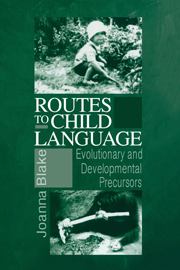Book contents
- Frontmatter
- Contents
- Preface
- 1 Prelinguistic Vocalizations
- 2 Sound–Meaning Correspondences
- 3 Communicative Gestures
- 4 Symbolic Gestures and Symbolic Play
- 5 Tool Use and Object Concept
- 6 Representation in Human Infants
- 7 Memory in Nonhuman Primates and Young Children
- 8 Origins of Language
- 9 Recapitulation
- References
- Index
3 - Communicative Gestures
Published online by Cambridge University Press: 12 January 2010
- Frontmatter
- Contents
- Preface
- 1 Prelinguistic Vocalizations
- 2 Sound–Meaning Correspondences
- 3 Communicative Gestures
- 4 Symbolic Gestures and Symbolic Play
- 5 Tool Use and Object Concept
- 6 Representation in Human Infants
- 7 Memory in Nonhuman Primates and Young Children
- 8 Origins of Language
- 9 Recapitulation
- References
- Index
Summary
What Is a Gesture?
Gesture is a common term used to describe anything from simple motor acts, such as catching and returning a ball (e.g., Rome-Flanders & Ricard, 1992) to vocal sounds (Lock, 1980; Vihman, 1991). A typical dictionary definition refers only to a “movement of the body, head, arms, hands, or face expressive of an idea or an emotion” (Barnhart, 1948, p. 509). Despite the extended use of the term gesture beyond this definition, in developmental research the term is often taken to mean only gestures that express an idea – that is, symbolic gestures. This restricted focus follows the influential work of Werner and Kaplan (1963), who originally made a distinction between expressive and depictive gestures. The boundary between the two types is often difficult to draw. Expressive movements are viewed as reactive or coactive patterns “directly involved in pragmatic commerce with objects” (Werner & Kaplan, 1963, p. 85). For example, an infant may react to the sound of music with a bodily rocking motion but later may use this motion to request music when it is not playing, a depictive gesture. A depictive or symbolic gesture, in the view of both Werner and Kaplan (1963) and of Piaget (1962), requires some distance (in time, space, and content) between the movement and that to which it refers. Such distancing is similar to the property of displacement in language described by Hockett (1958).
- Type
- Chapter
- Information
- Routes to Child LanguageEvolutionary and Developmental Precursors, pp. 78 - 110Publisher: Cambridge University PressPrint publication year: 2000



